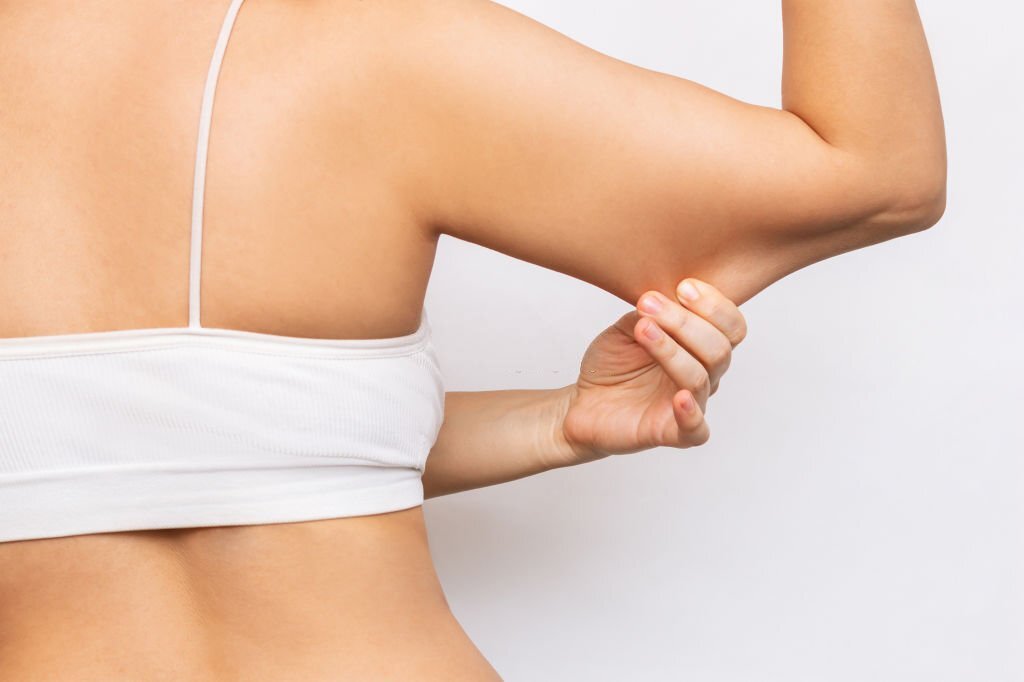Say Goodbye to Bat Wings with Brachioplasty
Are you tired of waving hello or goodbye and feeling self-conscious about your sagging upper arms? An arm lift (brachioplasty) could be the answer.
This article covers what you must know, from what it is, to its pros and cons, cost, surgery, recovery and everything in between.
What is Brachioplasty?
Brachioplasty is a cosmetic surgery procedure removing excess skin and fat from the upper arms. It’s the most effective way to remove extra skin (a.k.a. bat wings) along with fat deposits, and recontour the arms.
Aging, genetics, and significant weight fluctuations all contribute to sagging arm skin, which cannot be tightened through exercise and diet alone.
Brachioplasty can be combined with other body contouring procedures like liposuction, for removing unwanted fat and giving the arms a more toned, sculpted look.
Arm lift surgery may also be included in a mommy makeover or performed for patients who’ve experienced significant weight loss, as part of a more extensive body lift surgery, which includes other procedures like a tummy tuck, thigh lift, or breast lift.
Arm Lift vs. Liposuction
People often ask, why an arm lift rather than liposuction? The answer depends on whether the patient has excess fat with strong skin elasticity or more lax skin than fat.
Liposuction assists with fat removal, but it doesn’t shrink or tighten the skin.
For patients with excess fat and strong skin elasticity, liposuction provides better definition and contour. But if their skin is more laxed than fat, liposuction alone will create even more loose, droopy skin.
Pros and Cons of Brachioplasty

As with any medical procedure, there are pros and cons to consider before deciding whether brachioplasty is right for you.
Pros:
- Results are permanent (sagging skin may develop with age or weight gain).
- The procedure is considered safe and low-risk.
- Your clothing will fit better.
- You’ll feel more confident once the excess skin and fat are removed.
Cons:
- Scaring along your inner arm, from elbow to armpit. Scars fade over time, but never completely disappear.
- An inexperienced surgeon could leave you with asymmetrical arms.
Cost of Arm Lift Surgery

- Average Cost in US: $7,575
- High-end:$14,625
This is an elective cosmetic procedure, and therefore is not covered by insurance. Likewise, plan for all costs involved and ensure it’s within your budget.
Cost to account for:
- The consultation
- Surgeon’s fee
- Surgical facility
- Anesthesia fees
- Surgical supplies
- Prescription medications
- Recovery supplies
- Pre- and post-operative appointment fees
What Affects the Cost of Arm lift?
Several factors influence the cost of an arm lift, including:
- Surgeon’s qualifications and experience level.
- Procedure complexity.
- Type of anesthesia.
- Additional procedures.
- Where your surgery takes place.
Several factors influence an arm lift surgery. To get an accurate idea of how much the procedure will cost, let’s take a closer look at each of these factors.
Surgeon's Qualifications and Experience Level
One of the most significant factors affecting the cost of an arm lift is the surgeon’s qualifications and experience level.
Choose a board-certified plastic surgeon with experience performing arm lift procedures. It’s crucial to research before choosing one.
Look for a surgeon with a track record of successful surgeries and positive patient reviews. Before-and-after galleries will give you an idea of the surgeon’s aesthetic style and skill level.
Procedure Complexity
If excess skin and fat from your forearm is required, your surgery will be more complex and therefore more expensive.
Type of Anesthesia
The type of anesthesia used during your arm lift also affects the cost. General anesthesia, which puts you to sleep during the procedure, is typically more expensive than local anesthesia, which numbs only the treated region.
Additional Procedures
Many patients choose to combine their arm lift with other body contouring procedures, such as liposuction or a breast lift. Combining procedures can be a cost-effective way to achieve your desired results while also increases the overall surgical costs.
Insurance Coverage
An arm lift is considered a cosmetic procedure and is not covered by insurance. This means that you’ll be responsible for the full procedure cost, including any complementary procedures and anesthesia fees.
Surgery Location
Where your arm lift is performed impacts your cost; the location of the surgeon’s practice and the facility type.
Surgeons operating out of a hospital typically charge more than surgeons operating out of a private clinic due to the additional overhead.
Ask your surgeon to provide a full cost breakdown in addition to their fee. Include the operating room or hospital access, anesthesia, additional medical appointments, pain medication, and at-home care supplies post procedure.
Traveling Abroad Benefits

Looking for a more cost-effective way to undergo an arm lift?
Traveling abroad may be the perfect solution. In the U.S., arm lifts are expensive, making it challenging for most of us to afford.
Why Turkey is an Attractive Destination for Arm lift Surgery
Turkey has emerged as a popular destination for arm lift surgery, offering quality treatment at affordable prices.
Arm lift Surgery costs $7,575 on average in the United States, while this same treatment cost only $2,400 in Istanbul.
Here’s why Turkey is a top destination for arm lift surgery.
- Turkey has a long history of practicing medicine, with highly trained and experienced medical professionals, translating into a high standard of care.
- Arm lift surgery in Turkey cost significantly less than the same procedure in the US, UK and Australia. Save up to 750%, without compromising quality.
- Turkey’s rich history, offers patients a chance to combine surgery with a holiday.
Istanbul is a mecca for cosmetic surgeries due to its affordability and its highly professional and developed industry, designed to service the world’s cosmetic surgery needs.
Why plastic surgery is much cheaper in Turkey:
- Lower Operating Costs: Rent, utilities, and supplies, are much lower in Istanbul.
- Lower Labor Costs for medical professionals and operating room staff.
- Lower Marketing and Advertising Costs: Lower spend results in lower prices.
- Lower Malpractice Insurance Costs keep plastic surgery costs down.
- Fierce Competition among plastic surgeons in Istanbul, results in improved skill set and lower prices.
- Favorable exchange Rate: Each US dollar or Euro exchanges for 20 Turkish Lira.
Choosing a Surgeon in Turkey
When considering Turkey for your arm lift, choose a reputable and experienced surgeon. One way to ensure this is by looking for certifications from reputable organizations:
Research the surgeon’s experience, qualifications, and reviews from previous patients.
Preparation

What to do in preparation for your arm lift procedure:
- Obtain medical clearance from your primary care doctor.
- Undergo routine blood work.
- Stop certain medications and supplements that increase bleeding risk; anticoagulants, aspirin, and non-steroidal anti-inflammatory drugs.
- Stop smoking before and after the surgery to prevent tissue necrosis.
- Avoid alcohol to prevent serious complications.
- Fill required prescriptions needed during recovery.
- Arrange for child care, pet care, and household chores assistance, for 1-2 weeks following surgery.
- Stock up on loose-fitting, button-up shirts, not requiring raising arms to dress.
- Organize recovery space keeping water, snacks, reading materials and pillows in reach.
Surgery

Preparing for an Eyelid Lift Surgery
- Surgeon makes mark on arms, indicating incision points.
- Anesthesia is administered ensuring your comfort and safety.
- Incisions are made on the inner or back part of arms. Length and pattern depend on amount and location of the excess skin.
- Excess skin and fat are removed.
- Remaining skin will be tightened and sutured.
- Dressings are applied to incision sites.
A mini arm lift or “invisible arm lift surgery” is available for patients requiring only a moderate amount of extra skin and fat. These procedures usually involve liposuction, a shorter incision (about 2 inches long) right below the armpit, leaving a smaller, less noticeable brachioplasty scar. This technique takes about an hour.
Recovery from Arm lift surgery

- Initial post-surgery recovery may be uncomfortable. Discomfort abates typically in three or four days (more tightness than pain).
- Arms wrapped in bandages or in a compression sleeve (especially if you’ve had arm lipo), to keep swelling down and restrict movement.
- Bandages should be worn for up to 48 hours post-procedure, while you may be instructed to wear compression garments for up to four weeks. Compression sleeves can increase seroma risk. Be alert to discomfort or unusual swelling.
- Surgical drains may prevent fluid accumulating as you heal. Your doctor will remove the drainage tubes and non-dissolvable stitches at a follow-up appointment one-week post-op. Dissolvable stitches are reabsorbed by the body, within a week or two.
- You won’t be able to lift your arms above your shoulders for at least 14 days. Let incisions near armpit heal for four weeks before raising arms above the shoulders.
- Shower after 24 to 36 hours. Have someone wash your hair for you.
- Brachioplasty incisions take four to eight weeks to heal, avoid strenuous activity and heavy lifting until fully healed.
- Expect to be out of the office for at least two weeks.
- Your doctor may advise against driving for two weeks.
- Ease back into exercise once your surgeon gives you the go-ahead.
- Arm lift scars are treated with silicone sheets and serums and take a full year to mature. Ask about laser treatments to help fade and flatten them.
Pain Management
When undergoing an arm lift surgery, you will be given general anesthesia to ensure that you don’t feel any pain.
Your surgeon’s staff will provide you with pain medication to help you manage any discomfort. Any pain or discomfort should lessen after three or four days, although your arms may feel swollen, tight, and tender during this time.
Results

Results of an arm lift surgery last for ten years or more assuming a stable weight is maintained.
Skin naturally lose elasticity with aging, so consider nonsurgical skin-tightening treatments to ensure results longevity.
Risk
Like any surgical procedure, arm lift surgery carries some risks and potential complications. Although considered safe, you may experience swelling, bruising, hematoma, hypertrophic scarring, and minor wound-healing issues.
Incision separation during recovery is also common, especially in the armpit area, which is difficult to heal due to frequent motion and high bacterial counts from sweating.
While seroma, or fluid buildup, is common at the elbow, compression sleeves are not recommended to manage this condition; instead, keep arms straight to prevent it.
While nerve damage is rare, it is possible to experience temporary or permanent numbness around the incision area.
Major complications such as blood clots are rare, and scars typically heal, fade, and flatten over time.
It may take six to twelve months for scars to settle in the arm. Discuss your medical history with your surgeon to mitigate potential risks and ensure surgery suitability.
Alternatives to arm lift surgery:
Liposuction: removes excess fat from the arms and is a good option if you don’t have significant skin laxity. It can also be combined with an arm lift. The surgery is performed under local anesthesia and requires a week to 10 days of downtime.
BodyTite: is a minimally invasive procedure using radiofrequency energy to liquify fat and tighten skin. A small circular probe monitors skin temperature and prevent burns. Providers typically follow BodyTite with liposuction to remove the melted fat. This outpatient procedure is performed under local anesthesia, requires one week of downtime, and leaves behind tiny puncture marks.
Nonsurgical skin-tightening treatments: These treatments correct mild to moderate sagging by boosting collagen production. Ultherapy or SkinTyte are energy treatments used to achieve this.
These treatments do not reduce fat, and require numerous sessions over time to see results.
All of the above are a good option if you’re not looking for dramatic results or if you want to avoid arm lift scars and a lengthy recovery period.
If you’re considering an arm lift, understand factors affecting procedural cost, choose a qualified, experienced surgeon and consider complementary procedures to achieve your desired results.
Remember to factor in all of the costs associated with the procedure, including the initial consultation, surgeon’s fee, surgical facility, anesthesia fees, surgical supplies, prescription medications, recovery supplies, and pre- and post-operative appointment fees.
If you’re interested in an arm lift, we encourage you to find a board-certified plastic surgeon and schedule a consultation to discuss your goals and options.
Sources & studies
Get A Quote
Book an Appointment
Reviews
They recommended a crown and put it in without complications. They charged me exactly what they said they would and did not insist on trying to sell me another treatment, like so many dentists in the U.S. do…I’m sorry but it so true.
I will definitely be back! Thank you Hebedoc!
That's service and priority to someone in pain. Dr. Diaz took the proper conservative and cost- effective pathway to eliminating my pain and discomfort. So thankful to find such dedication and quality. Very good people, very helpful, doing good work!
Thank you for what you do and how you do it, superior patent care exits and is flourishing with the entire team. Highly recommended traveling to Tijuana. I’ve come to think of it as visiting the south side of San Diego, it’s that close!
Will definitely recommend, 10/10
